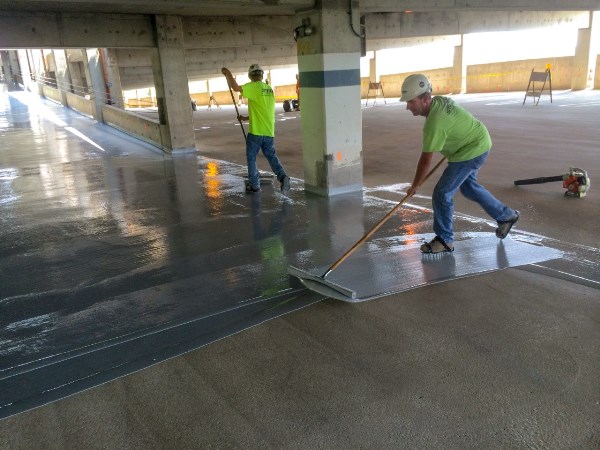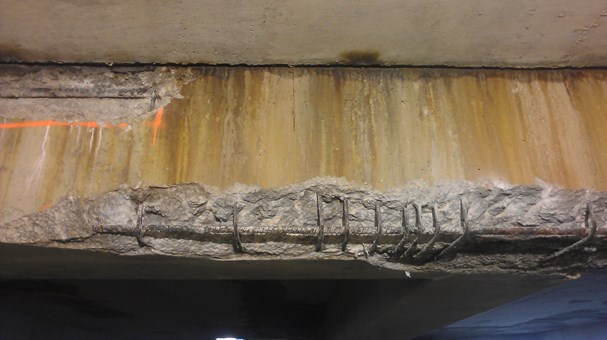The onset of colder winter months could soon usher in a new wave of concerns for the maintenance of parking structures, led by how facility managers can best mitigate issues related to corrosion.
Made of concrete and steel, major multi-level parking structures typically provide visitors and their vehicles with shelter from the elements and often provide access to housing or office space. Unfortunately, protecting the structure itself from the constant onslaught of environmental stressors, wear, and tear presents its own set of challenges.
According to Western Specialty Contractors (St. Louis, Missouri), a family owned specialty contractor with over 100 years of experience in masonry, concrete, and façade restoration, the water, oil, and muck typically left behind by vehicles is compounded in winter months by salt and deicers that are tracked in. All have the capability to corrode the structure’s concrete and steel support system.
An ineffective maintenance routine can quickly lead to costly repairs and restorations that can be disruptive to tenants and cause unexpected costs and safety concerns.
“Essentially, the goal of parking garage maintenance is to keep water and corrosives away from the garage’s reinforcing steel,” says Carter Pogue, project manager with Western. “The damaging and compounding cycle of water infiltration never gets better on its own, and the longer that warning signs are ignored, the more serious and costly the repairs can become.”
Types of Structures
The most common types of parking structures are double-T precast, conventional cast-in-place, and post-tensioned systems, the company explains.
The double-T precast system is comprised of load-bearing structures that resemble two T-beams connected to each other, side by side. The strong bond of the flange and the two webs, or stems, creates a structure that is capable of withstanding high loads while having a long span.
Conventional concrete structures are robust, with types including a beam and slab, a beam, slab, and joists, or a flat slab with no beams. These are frequently used in multi-purpose buildings.
Post-tensioning concrete with steel strand became a popular U.S. solution to deflection and weight issues in slabs in the 1950s. Used in both precast and cast-in-place concrete construction, post-tensioning is considered active reinforcement because it applies tension to the concrete. This process improves the structure’s stability and resistance to wind, gravity, and seismic forces.
Five Key Indicators
Within each of these systems, Western says, there are five key indicators that should tell facility managers that the structure is in need of preventive maintenance.

Leaking water is one sign that a garage is in need of repairs. The longer the condition is left unattended, the more expensive the consequences can become. Three indicators that water leakage is occurring are exposed rusted metals, rust stains along the walls, and efflorescence.
Similarly, standing water—or ponding—is also an indicator. A simple drain installation or protective waterproof membrane can prevent future, larger problems.
Failed expansion joints provide another avenue for water to penetrate and reach the reinforcing steel and T-beam connector plates, the contractor says, adding that detecting expansion joint problems and reacting quickly to make repairs can be beneficial in the long run. Wear at the T-beam to T-beam joints, expansion joint failure, and flange connection deterioration is commonly found in double-T precast structures.
In conventional and post-tensioned structures, damage in the form of delamination, spalling, and vertical and horizontal cracks in the concrete are key warning signs because they allow water to reach the structure’s reinforcing steel.
If exposed rebar can be seen, there is a problem that deserves swift attention. When rebar is introduced to water, it corrodes and expands up to eight times its original size. This condition usually is the result of a crack that allows water to enter the concrete and reach the rebar, the contractor says. The force of the expanding rebar causes more damage to the concrete around it, which creates greater access for water and more corrosion. When this occurs, the cycle needs to be stopped as soon as possible.

Need for Specialists
If these problems are seen, concrete maintenance and restoration are essential, the contractor says. By identifying specific problem areas and hazards within the garage and by recommending a repair plan and maintenance schedule, facility managers can delay or avoid costly restoration, decrease their liabilities, retain the ideal parking volume and rates for their facility, adhere to local permitting guidelines, and maintain the property’s value, Pogue says.
Restoration services that could resolve these problems include concrete repair and replacement, structural repairs, the installation or replacement of expansion joints, clear sealer application, deck coating installation, post-tension repair, epoxy injection, chemical grout injection, fiber-reinforced polymer system, cathodic protection, spray applied concrete (shotcrete), and sacrificial galvanic anodes, according to the contractor.
“Recent strides in technology have provided new and effective ways to extend the life of parking structures,” Pogue says. “These advances consist of conventional means, including better coatings and sealants, as well as all new methods of handling challenging concrete repairs.”
Source: Western Specialty Contractors, Web site: www.westernspecialtycontractors.com.